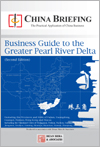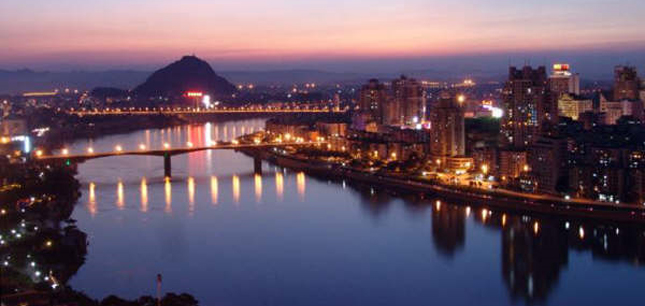Liuzhou Developing into Typical 2TC Investment Destination
Oct. 1 – Liuzhou, the second largest city in Guangxi and the region’s industrial center, is poised to become a major recipient of relocating domestic manufacturers and an investment hub for access to trade with South-East Asia. It is, in many ways, an archtypal second tier city.
The city, which is bisected by the Liujiang River in the central part of the Guangxi Zhuang Autonomous Region, has convenient land and water communications and is a newly developing industrial base. It is also rich in natural resources, being a major global supplier of zinc. It lies 150 kilometers from Guilin in the northeast, 250 kilometers from the provincial capital of Nanning in the southwest, and about 400 km from the sea ports at Beihai, Fangcheng, and Qinzhou.
To the east, Liuzhou is close to Guangdong, Hong Kong and Macao with their surging economies; in its south, it is next to the North Gulf and ASEAN, to its west, it is close to Yunnan, Guizhou and Sichuan province; In its north, it is connected to the middle and lower Yangtze Valley. Backing the southwest of China and facing southeast Asia, Liuzhou is located in the area where the south economic development zone (south China economic circle) and the southwest under-developed zone (southwest economic circle) connect. It has excellent road transportation and is connected directly to Hanoi (Vietnam) via the Dongxin and the Youyi Highways.
The city is gaining from two directions – close enough to the traditional South China investors from Hong Kong and Taiwan, it is receiving some of the investment that had previously been based in Guangdong. As land and labor costs rise, manufacturers from Guangdong are moving west – and Luizhou is becoming the preferred destination. Additionally, as regional trade increases, Luizhou finds itself as a new trading link to the China-ASEAN Free Trade Zone, giving it access to the newly emerging markets in South-East Asia by road, rail and sea. The city possesses a tri-dimensional transportation network of railway, road, waterway and air connections, and is also the railway hinge that connects southwest China, central China and south China, being the point where these railway trunks converge. This combination of transportation links and access to new markets elsewhere in China and beyond is proving increasingly attractive.
Chinese national manufacturers certainly think so. Liuzhou has developed an increasingly vibrant manufacturing base, and especially in auto and related components in China, with all of the nations top three auto manufacturers having factories and production facilities in the sity. Specializing in business utility vehicles, minibuses, special purpose vehicles and heavy-duty lorries and so on, in addition to automotive spare parts have made Liuzhou an attractive alternative to national manufacturers either relocating from Guangdong, expanding domestically and wishing to service south China markets. Metallurgy is also a primary industry; Liuzhou zinc is traded on the LME. Third party logistics is a developing industry as the city starts to integrate with South-West China and the development of trade in Southeast Asia through nearby Vietnam. Manufacturers hit by rising land and labor costs in Guangdong province have been relocating to the area, which enjoys a balmy climate with moderate winters.
Liuzhou airport is meanwhile is well connected with regular flights to all major Chinese cities, while the Liu river is navigable, has local port and cargo facilities and provides transportation to the provincial capital, Nanning. The city is additionally developing as a third party logistics hub for Southwest China and the ASEAN region.
Glamour is arriving too, it is, like Shanghai, on the Formula One racing circuit. Liuzhou hosts the Chinese F1 World Speed Boats Championships in October. Excellent connections to Guangdong, Hong Kong and increasingly to Vietnam and Southeast Asia make it a second tier manufacturing location to watch.
 This article was aggregated from the forthcoming China Briefing Regional Guide to the Greater Pearl River Delta, which will be available after the National October Holidays, priced at US$25 plus p&p. The book details the provinces and SARs of Fujian, Guangdong, Guangxim, Hainan, Hong Kong and Macau, and the South China cities of Dongguan, Foshan, Fuzhou, Guangzhou, Haikou, Huizhou, Jiangmen, Liuzhou, Nanning, Shantou, Shenzhen, Xiamen, Zhanjiang and Zhuhai. Pre-publication orders can be made through sales@china-briefing.com.
This article was aggregated from the forthcoming China Briefing Regional Guide to the Greater Pearl River Delta, which will be available after the National October Holidays, priced at US$25 plus p&p. The book details the provinces and SARs of Fujian, Guangdong, Guangxim, Hainan, Hong Kong and Macau, and the South China cities of Dongguan, Foshan, Fuzhou, Guangzhou, Haikou, Huizhou, Jiangmen, Liuzhou, Nanning, Shantou, Shenzhen, Xiamen, Zhanjiang and Zhuhai. Pre-publication orders can be made through sales@china-briefing.com.
Inquiries or assistance with investment in Liuzhou can be directed to Dezan Shira & Associates at info@dezshira.com.
- Previous Article Hong Kong Business Leaders: Inflation a Priority
- Next Article Yichang Develops as Yangtze River Trade Gateway





























